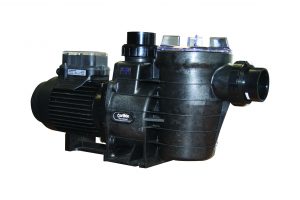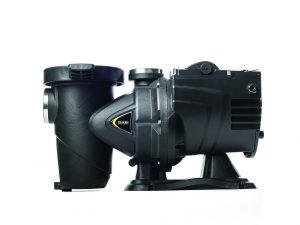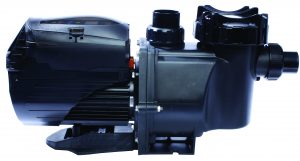Variable speed pumps: an explanation
With energy and cost savings on offer, Patrick Thorpe takes a closer look at variable speed pumps and uncovers the benefits behind their use.
When asked about variable speed pumps, I often start by saying I think the name is misleading! It gives the impression that the speed is constantly changing day in and day out. We all know we need a constant flow so what is the point?
I prefer to refer to them as speed adjustable pumps. Most Variable Speed pumps have three settings each capable of being adjusted to an exact speed. For the moment let’s concentrate on using just one of the three. By being able to set one speed to the exact flow rate set by the pool designer, we end up with a perfectly balanced pool, then as almost a by-product, we have all the advantages of the pump affinity laws.
Let me give you an example: let’s say you are building a 10m x 5m x 1.4m (average depth) domestic pool (70m3), and you would like to have a turnover rate of 6 hours, then you are looking for a pump capable of producing 12m3/h.
You look in your supplier price list and find a 1½ hp pump at a 10m head is not quite powerful enough, so you have to select a ¾hp. That in itself creates another issue, instead of being able to use a 600mm filter you are forced to go for a 750mm.
OK now let’s consider using a 1hp Variable Speed pump. The first saving is we can stick with using a 600mm filter, as it will comfortably deal with the 12m3/h required.
The concept of Variable Speed is as simple as one, two, three:
ONE: Any change in speed directly changes the flow at the same rates, i.e. 50% of the speed = 50% of the flow. Changes in flow rate are to the power of ONE.
TWO: Any change in speed changes the head in the system to the power of TWO. i.e. 50% of speed = 10m head x 0.5 x 0.5 so the head changes to 2.5m.
THREE: Any change in speed changes the power used to the power of THREE. i.e. 50% speed = electricity used x 0.5 x 0.5 x 0.5 therefore 1kW becomes 125kW
Now let’s go back to our example of a typical ¾hp pump that uses about 820 watts. We are running a heat pump and want to run the pool say 10 hours a day:
3/4hp pump 820W x 10 = 8.2kW. Say 180 days x 8.2kW = 1476kW. At 12p kW/h = £177.12
1hp Variable Speed pump 1,050 watts at 2,850 rpm producing 17m3/h. Flow required = 12m3/h. Speed required (Power 1) 12/17 x 2,850 = 2,012 rpm (this will depend on the actual hydraulic efficiency of the system, but the calculation should give an excellent indicator of the saving). 12/17 = 70% of the speed. Power used = 1,050 x 0.7 x 0.7 x 0.7 = 360W. Pump 360W x 10 hours = 3.6kW. Say 180 days x 3.6kW = 648kW. At 12p kW/h = £77.76
So where are we? We are using a pump producing exactly the flow rate set by the pool designer working at a power consumption commensurate with that flow rate and at the same time, no dead area issues, no flow rate issues, yet still saving £100 per year. Not forgetting a saving on buying the smaller filter of at least £350 at retail, which means, you will be well on the way to covering the extra cost of buying the variable speed pump. No compromise, just perfection.
Obviously greater savings can be made by running a much lower speed for part of the day, as long as you ensure you have sufficient flow to operative such items as the heat pump and dosing, etc., not to mention numerous other benefits like medium rate filtration.
Go on give them a try!



This article was written by PATRICK THORPE, and first published in the December 2016 edition of Swimming Pool News. Patrick is former Managing Director of AstralPool UK Ltd, former Chairman of Certikin International Ltd and a key member of SPATA’s Technical Committee.



